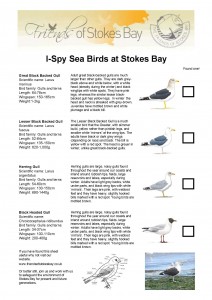As you walk along the Bay you may notice the Sea Birds swooping down to inspect items lying on the beach.
These Sea Birds are probably Gulls and they are omnivorius scavengers, taking advantage of things dropped by visitors or items washed up by the tide.
Sometimes the Great Black Backed gulls congregate around the outlet of the River Alver at the west end of the beach, so that they can take advantage of the rocky pools to scavenge for bits and pieces to eat.
The Black Headed Gulls are more shy but can be seen wading along the low tide line and also they land inland when the season is wet, paddling in the pools west of No.2 Battery.
Here are some of the Sea Birds that you may be able to identify, although they are sometimes very difficult to distinguish from each other.
| Great Black Backed Gull Scientific name: Larus marinus Bird family: Gulls and terns Length: 64-78cm Wingspan: 150-165cm Weight:1-2kg |
Adult great black-backed gulls are much larger than other gulls. They are dark grey-black above and white below, with a white head (streaky during the winter) and black wingtips with white spots. They have pink legs, whereas the similar lesser black-backed gull has yellow legs. Their beak is powerful and they will use it to bully other birds, stealing their food. In winter the head and neck is streaked with grey-brown.Juveniles have mottled brown and white plumage and a black bill. They eat shellfish, carrion, insects, scraps, crustaceans and other birds. They are omnivorous. https://www.rspb.org.uk/birds-and-wildlife/wildlife-guides/bird-a-z/great-black-backed-gull/ |
||
| Lesser Black Backed Gull Scientific name: Larus fuscus Bird family: Gulls and terns Length: 52-64cm Wingspan: 135-150cm Weight: 620-1,000g |
The Lesser Black Backed Gull is a much smaller bird that the Greater, with slimmer build, yellow rather than pinkish legs, and smaller white “mirrors” at the wing tips. The adults have black or dark grey wings (depending on race) and back. The bill is yellow with a red spot. The head is greyer in winter, unlike great black-backed gulls. Like their bigger relative they are omnivores and they eat fish, insects, crustaceans, worms, starfish, molluscs, seeds, berries, small mammals, eggs, small birds, chicks, scraps, offal, and carrion. https://www.rspb.org.uk/birds-and-wildlife/wildlife-guides/bird-a-z/lesser-black-backed-gull/ |
||
| Herring Gull Scientific name: Larus argentatus Bird family: Gulls and terns Length: 54-60cm Wingspan: 130-150cm Weight: 690-1440g |
Herring gulls are large, noisy gulls found throughout the year around our coasts and inland around rubbish tips, fields, large reservoirs and lakes, especially during winter. Adults have light grey backs, white under parts, and black wing tips with white ‘mirrors’. Their legs are pink, with webbed feet and they have heavy, slightly hooked bills marked with a red spot. Young birds are mottled brown. They are ominivorous and will eat carrion, offal, seeds, fruits, young birds, eggs, small mammals, insects and fish. https://www.rspb.org.uk/birds-and-wildlife/wildlife-guides/bird-a-z/herring-gull/ |
||
| Black Headed Gull Scientific name: Chroicocephalus ridibundus Bird family: Gulls and terns Length: 34-37cm Wingspan: 100-110cm Weight: 200-400g |
For most of the year this bird has a white head. The summer adult has a chocolate-brown head which does look black from a distance, pale grey body, black tips to the primary wing feathers, and red bill and legs. The hood is lost in winter, leaving just two dark spots. Immature birds have a mottled pattern of brown spots over most of the bodyIt is most definitely not a ‘seagull’ and is found commonly almost anywhere inland. They eat Worms, insects, fish and carrion. https://www.rspb.org.uk/birds-and-wildlife/wildlife-guides/bird-a-z/black-headed-gull/ |
 |
The next time you are going to visit Stokes Bay Beach download, print and take this handy guide with you. See if you can find an example of each. Great fun for the children, and adults!Download as PDF file I-Spy Sea Birds on Stokes Bay BeachIf you manage to take a photo of any of these sea birds (not easy) we would like to see it! |